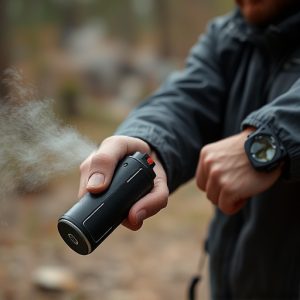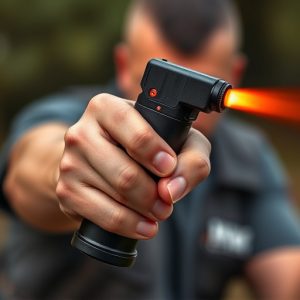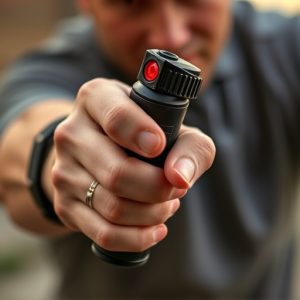Non-Lethal Pepper Spray Defense: A Comprehensive Guide for Civilians
Non-lethal pepper spray defense, a powerful and portable self-defense tool, temporarily incapacitate…….
Non-lethal pepper spray defense, a powerful and portable self-defense tool, temporarily incapacitates assailants with capsaicin, causing skin irritation and tear production. Legalities vary globally, so users should check local regulations. This spray can deter attacks, disrupt encounters, and provide security during various scenarios, making it an appealing last line of defense without lethal force. When selecting a non-lethal pepper spray, consider specific needs, potential threats, and compliance with local laws.
“In an era where personal safety is a paramount concern, understanding non-lethal pepper spray defense has become essential for civilians. This comprehensive guide explores the multifaceted world of defensive spray, offering insights into its benefits and applications in everyday protection. From the science behind its effectiveness to legal considerations and choosing the right product, we demystify this powerful tool. Learn how non-lethal pepper spray can empower individuals to defend themselves with confidence and stay safe in various scenarios.”
- Understanding Non-Lethal Pepper Spray: A Comprehensive Overview
- Benefits and Applications in Civilian Protection
- How Non-Lethal Pepper Spray Works: The Science Behind It
- Legal Considerations and Regulations for Civilian Use
- Choosing the Right Pepper Spray for Your Needs
Understanding Non-Lethal Pepper Spray: A Comprehensive Overview
Non-lethal pepper spray, often referred to as defensive spray, is a powerful yet non-deadly tool for personal protection. It’s designed to incapacitate an attacker temporarily, giving users time to escape or call for help. This type of spray is a popular choice for civilians seeking self-defense options due to its ease of use and minimal harm inflicted on the target. The active ingredient in most pepper sprays is capsaicin, a chemical derived from chili peppers that causes skin irritation and tears when it comes into contact with eyes and mucous membranes.
When deployed, non-lethal pepper spray creates a burning sensation, making it difficult for the user to breathe and move effectively. This temporary incapacitation can last anywhere from several seconds to a few minutes, which is often enough to disrupt an attack and allow the user to gain control of the situation. It’s important to note that while these sprays are generally legal to carry without a permit in many places, local regulations vary, so users should always familiarize themselves with their area’s laws regarding non-lethal pepper spray defense.
Benefits and Applications in Civilian Protection
Defensive spray, particularly non-lethal pepper spray, offers civilians a powerful tool for personal protection in various scenarios. Its primary benefit lies in its ability to incapacitate an assailant temporarily, providing the user with time to escape or seek help. This is especially crucial in situations where one might be outnumbered or facing a potential threat without immediate access to other self-defense options.
The applications of pepper spray are diverse. It can deter and disrupt attacks, giving users a chance to de-escalate potentially dangerous encounters. Whether it’s during a mugging, home invasion, or even while traveling alone in unfamiliar places, non-lethal pepper spray serves as a reliable last line of defense. Its portability and ease of use make it an appealing option for individuals seeking to protect themselves without resorting to lethal force.
How Non-Lethal Pepper Spray Works: The Science Behind It
Non-lethal pepper spray, also known as defense spray, is designed to incapacitate an assailant temporarily without causing permanent harm. Its primary active ingredient is capsaicin, the compound that gives chili peppers their heat. When sprayed into the eyes and respiratory system, capsaicin binds to pain receptors, triggering a burning sensation and intense irritation. This overwhelming sensory input disrupts the attacker’s balance, vision, and breathing, providing the user with crucial time to escape or seek help.
The science behind non-lethal pepper spray is based on understanding how our bodies react to capsaicin. Once sprayed, the chemical vapor spreads rapidly, dissolving in the mucous membranes of the eyes and nose. This causes a series of physiological responses, including increased heart rate, constriction of airways, and excessive salivation. These effects are designed to be painful and disorienting but not fatal, making it a powerful tool for civilian self-defense against potential threats.
Legal Considerations and Regulations for Civilian Use
The legality of civilian use of defensive spray, particularly non-lethal pepper spray, varies significantly across jurisdictions worldwide. In many countries and states, individuals have the right to carry and use pepper spray for self-defense purposes, provided they comply with specific regulations. These rules often dictate the type and amount of active ingredient allowed in the spray, as well as restrictions on where and how it can be carried. For instance, some regions permit only low-dose, non-lethal formulations, while others have specific requirements for storage and labeling.
Civilian users must also be aware of local laws regarding age restrictions, necessary permits, and conditions under which the spray can be legally employed. Misuse or illegal carrying of pepper spray can lead to severe penalties, including fines and imprisonment. Therefore, understanding and adhering to these legal considerations are paramount for anyone considering the acquisition and use of non-lethal pepper spray as a personal defense measure.
Choosing the Right Pepper Spray for Your Needs
When considering a non-lethal pepper spray for civilian protection, it’s essential to match your choice with specific needs and potential threats. Different pepper sprays offer varying levels of potency, ranges, and carrying capacities. For personal safety in close quarters, like homes or vehicles, a powerful yet compact spray with a shorter range might be suitable. In contrast, for outdoor activities or self-defense against multiple attackers, a longer-range option could provide more tactical advantages.
Features such as stream versus mist settings, weather resistance, and ease of use are also critical considerations. Some sprays include additional tools like holsters, keychains, or alarm functions, enhancing convenience and accessibility. Always check local laws regarding pepper spray ownership and usage to ensure compliance, as regulations vary widely.
In conclusion, non-lethal pepper spray defense has emerged as a powerful tool for civilian protection, offering a range of benefits and applications. Understanding its science, legal considerations, and choosing the right product are key steps to ensuring its effective use. Armed with knowledge, individuals can take control of their safety and security in various situations, making non-lethal pepper spray a valuable addition to their personal defense arsenal.


